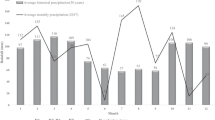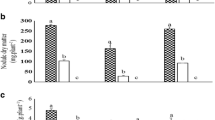Abstract
The high protein content of soybean (Glycine max) seeds results in high nitrogen demand, causing a huge nitrogen uptake during plant growth. As a legume crop, soybean can fix atmospheric N through symbiotic associations with Bradyrhizobia and perform well in African nitrogen poor soils. This study aimed at establishing the ability of promiscuous soybean genotypes to fix nitrogen and devise the relationship between nodule scores and amount of nitrogen fixed. Twelve soybean genotypes were inoculated with Bradyrhizobium japonicum Strain USDA 110 (specific) and Bradyrhizobium sp. Strain USDA 3456 (native) and raised in pots in a greenhouse. At the R3.5 growth stage, nodules were scored and xylem sap was extracted, which xylem sap was used to carry out ureide, amino-N, and nitrates assays. The relative abundance of ureide was used to devise the proportion of nitrogen fixed by each genotype. The proportion of nitrogen derived from atmospheric N2 (Ndfa) ranged from 47.9 to 78.8% under USDA 3456 and from 36.7 to 78.7% under USDA 110. A strong correlation was found between nodule scores, especially nodules’ effectiveness, and Ndfa. The genotypes Wondersoya (78.8%), Maksoy 2N (78.4%), Namsoy 3 (78.3%), and Maksoy 3N (75.7%) had high nitrogen-fixing ability in response to USDA 3456. Promiscuous soybean genotypes can fix nitrogen equally under both native and specific Bradyrhizobium types. Nodules’ effectiveness can be a good predictor of biological nitrogen fixation. This study highlighted that crop improvement to boost soybean production in Africa should target promiscuous varieties for better yield with less inputs.
Similar content being viewed by others
References
Agoyi EE, Afutu E, Tumuhairwe JB, Odong TL, Tukamuhabwa P. 2016. Screening soybean genotypes for promiscuous symbiotic association with bradyrhizobium strains. Afr. Crop Sci. J. 24: 49–59
Bezdicek DF, Evans DW, Adebe B, Witters RE. 1978. Evaluation of peat and granular inoculum for soybean yield and N fixation under irrigation. Agron. J. 70: 865–868
Cataldo DA, Haroon M, Schrader LE, Youngs VL. 1975. Rapid colorimetric determination of nitrate in plant tissue by nitration of salicylic acid. Comm. Soil Sci. Plant Anal. 6: 71–80
Giller KE, Cadisch G, Ehaliotis C, Adams E, Sakala W, Mafongoya P. 1997. Building soil nitrogen capital in Africa. In: Buresh R, Sanchez P, Calhoun F, eds. Replenishing soil fertility in Africa. American Society for Agronomy, Crop Science Society of America, Soil Science Society of America: Madison, WI., pp 151–192
Giller KE. 2001. Nitrogen Fixation in Tropical Cropping Systems. Second Edition. CABI Publishing, Wallingford, UK
Gwata ET, Wofford DS, Pfahler PL, Boote KJ. 2004. Genetics of promiscuous nodulation in soybean: Nodule dry weight and leaf color score. J. Hered. 95: 154–157
Hailu T. 2011. Breeding for promiscuous soybeans at IITA, Soybean–Molecular Aspects of Breeding. In: Sudaric A, edn. In: Tech. Available from: http://www.intechopen.com/books/soybean-molecular-aspects-of-breeding/breeding-forpromiscuous-soybeans-at-IITA Accessed on the 8th May 2016
Herridge DF, Betts JH. 1988. Field evaluation of soybean genotypes selected for enhanced capacity to nodulate and fix nitrogen in the presence of nitrate. Plant Soil 110: 129–135
Herridge DF, Holland JF. 1987. Effects of tillage on plant available nitrogen and N~ fixation by soybean. In: PE Bacon, J Evans, PR Storrier, AR Taylor, eds., Nitrogen Cycling in Agricultural Systems of Temperate Australia. Australia Society of Soil Science Inc., Wagga Wagga, Australia, pp 390–396
Herridge DF, Marcellos H, Felton W. Turner G, Peoples M. 1998. Chickpea in wheat based cropping systems of northern New South Wales III. Prediction of N2 fixation and N balance using soil nitrate at sowing and chickpea yield. Aust. J. Agric. Res. 49: 409–418
Herridge DF. 1984. Effects of nitrate and plant development on the abundance of nitrogenous solutes in root-bleeding and vacuum-extracted exudates of soybean. Crop Sci. 25: 173–179.
IITA. 1996. Understanding nitrogen fixation in promiscuous soybean. In: Microbiology in the service of crops and soils. Annual Report, IITA 1996: Ibadan, Nigeria 389 p
Khan DF, Peoples M, Schwenke G, Felton WL, Chen D, Herridge DF. 2003. Effects of below-ground nitrogen on N balances of field-grown fababean, chickpea and barley. Australian Journal of Agricultural Research 54: 333–340
Lima E, Boddey R, Döbereiner J. 1987. Quantifiation of biological nitrogen fixation associated with sugar cane using a 15N aided nitrogen balance. Soil Biol. Biochem. 19: 165–170
Mirza NA, Bohlool BB, Somasegaran P. 1990. Nondestructive chlorophyll assay for screening of strains of Bradyrhizobium japonicum. Soil Biol. Biochem. 22: 203–207
Okalebo JR, Gathua KW, Woomer PL. 2002. Laboratory Methods of Soil and Plant Analysis: A Working Manual, KARI, SSSEA, TSBF, SACRED Africa. 2nd edn., Moi University, Nairobi, Kenya
Payne RW, Harding SA, Murray A, Soutar DM, Baird DB, Glaser AI. 2011. The guide to Genstat release 14, Part 2: Statistics. Hemel Hempstead, Hertfordshire HP1 1ES, UK: VSN International
Purcell L, Serraj R, Sinclair T, De A. 2004. Soybean N2 fixation estimates, ureide concentrations, and yield responses to drought. Crop Sci. 44: 484–492
Salvagiotti F, Cassman KG, Specht JE, Walters DT, Weiss A, Doberman A. 2008. Nitrogen uptake, fixation and response to fertilizer N in soybean: A review. Field Crops Research 108: 1–13
Shiraiwa T, Sinclair TR, Hashikawa U. 1994. Variability in nitrogen fixation activity among soybean cultivars grown under field conditions. Jpn. J. Crop Sci. 63: 111–117
Sinclair TR, Soffes AR, Hinson K, Albrecht SL, Pfahler PL. 1991. Genotypic variation in soybean nodule number and weight. Crop Sci. 31: 301–304
Sprent JI. 2001. Nodulation in Legumes. Kew: Royal Botanical Gardens
Takahashi Y, Chinushi T, Nakano T, Ohyama T. 1992. Evaluation of N2 fixation and N absorption activity by relative ureide method in field-grown soybean plants with deep placement of coated urea. Soil Sci. Plant Nutr. 38: 699–708
Thuita M, Pypers P, Herrmann L, Okalebo RJ, Othieno C, Muema E, Lesueur D. 2012. Commercial rhizobial inoculants significantly enhance growth and nitrogen fixation of a promiscuous soybean variety in Kenyan soils. Biol. Fert. Soils 48: 87–96
Unkovich M, Herridge D, Peoples M, Cadisch G, Boddey R, Giller K, Alves B, Chalk P. 2008. Measuring plant-associated nitrogen fixation in agricultural systems. ACIAR Monograph No. 136, 258 pages. downloadable from www.aciar.gov.au
Urquiaga S, Cruz KHS, Boddey RM. 1992. Contribution of nitrogen fixation to sugar cane: nitrogen-15 and nitrogen balance estimates. Soil Sci. Soc. Amer. J. 56: 105–114
Werner D, Newton WE. 2005. Nitrogen Fixation in Agriculture, Forestry, Ecology and the Environment, pp 255–276. Springer, Netherlands
Yemm EW, Cocking EF. 1955. The determination of amino acids with ninhydrin. Analyst 80: 209–213
Young E, Conway CF, 1942. On the estimation of allantoin by the Remini-Shryver reaction. J. Biol. Chem. 142: 839–853
Zoundji CC, Houngnandan P, Dedehouanou H, Toukourou F. 2016. Determinants of soybean [glycine max (l.) merrill] production system in Benin. J. Exper. Biol. Agric. Sci. 3: 430–439
Author information
Authors and Affiliations
Corresponding author
Rights and permissions
About this article
Cite this article
Agoyi, E.E., Afutu, E., Chadare, F.J. et al. Ureide essay to assess N2-fixation abilities of soybean (Glycine max) genotypes under different Bradyrhizobium strains. J. Crop Sci. Biotechnol. 20, 65–72 (2017). https://doi.org/10.1007/s12892-016-0132-0
Received:
Revised:
Accepted:
Published:
Issue Date:
DOI: https://doi.org/10.1007/s12892-016-0132-0




